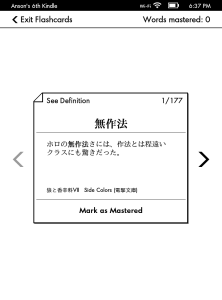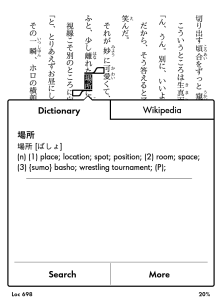Kindle Paperwhite – The Ultimate Language Learning Tool
The eReader market has been growing exponentially as Amazon keeps pushing out new models for cheaper and cheaper. The main draw for these devices are the beautiful eInk screens that mimic printed pages. The eInk’s major weaknesses are the slow refresh rates and the black and white color. Because of these characteristics, the screens have been adapted by eReaders mainly for the purpose of reading novels. Personally I think the new Kindle Paperwhite is a fantastic device to pick up brush up on a new language.
International Stores
Amazon has really dominated the eReader market, and despite efforts from Kobo and Barnes and Noble, they’ve really been the only company to take part in markets around the world. Amazon doesn’t just offer English eBooks on the American website Amazon.com, but you can also reach into Amazon’s international websites for eBooks in other languages. Here’s a brief list:
- English – Amazon.com
- French – Amazon.fr
- Japanese – Amazon.co.jp
- German – Amazon.de
- Chinese – Amazon.cn
- Spanish – Amazon.es
- Italian – Amazon.it
There’s always the option to load in free foreign books from other sources, but it’s nice to have an actual store as well. For me, I’m shocked at how cheap books are in China and they are reasonably priced in Japan as well. French books have been a bit pricier than I’d like, but nevertheless I now have access and can at least use my Kindle to check out what are the top books in that region. The Kindle stores have opened up a whole new world for me in terms of reading foreign books. I can now read what they are reading rather than books recommended to me by my professors or yet another translation of Harry Potter.
One of the weaknesses is that the Kindle Paperwhite can only be registered to one region at a time. This isn’t as bad as it sounds because once you purchase and download a book, it is there on your Paperwhite regardless of whether you change regions. All of Amazon’s features, such as X-ray, also remain after you deregister and choose another region. This includes the sync feature. So if I have bought an English book, swapped to my French account, my English book will still sync to my Amazon.com account and flip to the right page on my phone.
Dictionary
The Kindles have always had a great dictionary feature. On the Paperwhite, you just tap on the word and they will search it up on a dictionary. If you are tied to WiFi or 3G, you can even search it up on Wikipedia or get a translation courtesy of Bing Translation. Translations are nice, but it’s not all that handy. You have to tap several times to get there. However, the dictionary has been invaluable even in my native language because it is so simple to use. Just tap and you get a popup with the definition. This is valuable for learners of another language because everyone knows searching up words on a real life dictionary is a hassle. The Kindle’s tap and search approach helps make definitions almost seemless in your reading. If you are at a higher level in your language learning, Amazon already includes a dictionary for every language on the list above, so you have the Chinese-Chinese or German-German dictionary. That means you can search up German words and get a German definition in the form of sentences. If you are picking up a newer language, you’d probably much appreciate a dictionary that will just translate the word back into English. Unfortunately Amazon does not offer these dictionaries for free. You’ll have to purchase a Japanese-English dictionary or French-English dictionary instead on the Amazon.com site. Most of these dictionaries are quite good and reasonably priced as well. You may even find them online for free.
To save some hassle for those picking up the same things I am, I’ve been using this Japanese-English dictionary and this French-English dictionary. I’ve also compiled my own Chinese-English dictionary (with Cantonese pronunciations) which can be downloaded here. Having a dictionary on hand really increases your reading level. Because searching up words is not as much of a hassle as before, you aren’t looking for novels that have one or two vocabulary a page. It is possible to read a paragraph and search up a good dozen words without being annoyed. I’d certainly recommend better than that, probably 5-10 vocabulary words in a page, but in any case, this allows you to read harder books, get familiar with harder vocabulary and more complex grammar. In essence, you are using electronic tools to reach higher and faster.
Vocabulary Builder
Amazon’s latest model, the Kindle Paperwhite 2, also introduces a new feature called Vocabulary Builder. Of course, most tech blogs brushed it off as another gimmick and Amazon has been using it to target parents who are buying Kindles for their children. I’ve been using it for another language. It works as a basic flash card application. Every word you tap on to search a definition for will be added to a list. When you turn on Vocabulary Builder you will see a list of all these words.

When you enter flash card mode, the Kindle will feed you one word at a time. In addition to putting the word, they also extract the sentence so you get some context as well. Of course, the definition is shown when you flip it over, and there you can choose whether you have mastered it or not. This is hardly the greatest flash card application. I do like that they take the entire sentence to show you a sample of how the word is used, but this doesn’t take advantage of spaced repetition systems, nor does it give you multiple piles to work with. One other major caveat is that the list gets erased every time you deregister your account. At the end of the day, it is a bare bones basic flash card application. However, it is a nice bonus considering what I’ve been using my Kindle for.

Miscellaneous
Asides from these key features that will help you get foreign books and start recognizing and learning vocabulary, the Kindle is an eReader with many more generic features. Bookmarks are a huge help, so is the ability to carry some games and more comfortable and familiar books. I’d like to highlight the syncing feature as quite important. I’m always trying to cram a few minutes of learning here and there whether I’m waiting for a bus or a meeting. Kindle Paperwhite is a small lightweight device, but I still don’t have it with me everywhere. That’s where syncing comes in. You can read your book on the Kindle and then pick up right where you left off with the Kindle App on your smartphones so you never skip a beat. When you are actually reading, you can also highlight certain sections so you can go back to a particularly troubling phrase further down the road or just note down some really beautiful phrases. Amazon has also tried to cram in Facebook, Twitter and now Goodreads into the device. They were hoping you’d post up excerpts to show your friends, but you can use it to ask your friends for help or something along those lines.
Conclusion
To wrap up, the Kindle Paperwhite is a great device to get yourself back on a rusty second language. Truthfully it isn’t a full course, you won’t be learning anything directly, you will just be reinforcing your language skills. If you are actually trying to learn a language from scratch, I suppose there are language learning eBooks out there, but I think the Paperwhite’s strongest asset is the ability to push readers faster and harder than before and really help build vocabulary in due time.


Leave a Reply